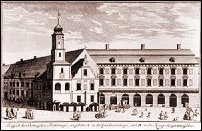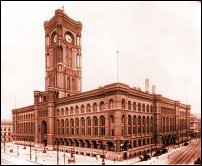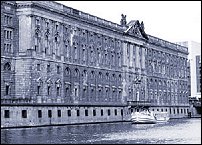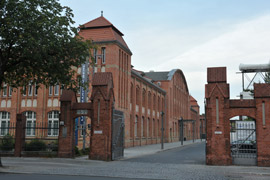History
Although the oldest statutes of the council of the twin city Berlin and Cölln from the year 1307 contained provisions for the safekeeping of documents in a vessel, it is only since the introduction of Stein’s Municipal Ordinance (Steinsche Städteordnung) [SA1] in 1808 that we can speak of archive formation in a modern sense. Until then, various chests, cabinets, and lockers served as an ‘archive’ for the city administration. Up to the sixteenth century, several fires in the city hall destroyed valuable documents.

In 1824 Johann Friedrich Zander was entrusted with the management of the archive. His successor in 1846 was Ernst Fidicin, who earned great merits as the first full-time archivist by editing Berlin’s official documents. However, the archive did not find suitable premises during his time, nor that of his successor, Posen state archivist Paul Clauswitz. Accommodation in the Rotes Rathaus, dedicated in 1869, did not bring major improvement. Thus, only partial acquisition of archival materials was possible in the nineteenth century. Important registries remained with the respective authorities, evading archival control. Archivists often could not compensate for the resulting losses.

Nevertheless, significant acquisitions were made after the formation of the municipality of Greater Berlin in 1920. Under the leadership of Ernst Kaeber, appointed in 1913, the archive personnel was developed. The archive distinguished itself as a central archive for municipal central administration, district administrations, and their respective subordinate institutions.
During the Second World War, holdings kept in the municipal archive were relocated to different places outside of Berlin. While many of these archival materials were returned to the city archive in the 1950s and 1960s, to this day numerous holdings are marked by loss and damage due to the consequences of war.

In July 1945 the city archive resumed its work. The division of the archive began in 1948 with the division of the municipal administration. The city archive (Stadtarchiv) remained in the eastern part of the city, moving into the Spree wing of the royal stables in 1966, and performing the tasks of a state archive as of 1976. In West Berlin a new city archive was founded, later the Landesarchiv, which became a state archive with the Berlin Constitution of 1950. As of 1976 it was housed on Kalckreuthstraße in the district Schöneberg. Both archives of the divided city were responsible for the records of state and district authorities, authorities of the Berlin districts, and all subordinate institutions.

In 1991 the Landesarchiv united with the Stadtarchiv Berlin, the Büro für Stadtgeschichtliche Dokumentation (Office of Municipal Historical Documentation and Technical Services), as well as the administrative archive of the Magistrat, to form a new institution for all of Berlin. The integration of the archive department of the Landesbildstelle and the archive of the International Architecture Exhibition (IBA) in 2000 constituted further valuable additions to the Landesarchiv. The Landesarchiv is now the audiovisual media archive for the state of Berlin.

Since July 2001, the Landesarchiv Berlin has been located in a former factory building. More than 20,000 m², the landmarked brick building from the turn of the century is part of an extensive complex built for the German Weapons and Munitions Factory (DWM) between 1906 and 1918 in the Wittenau area.



